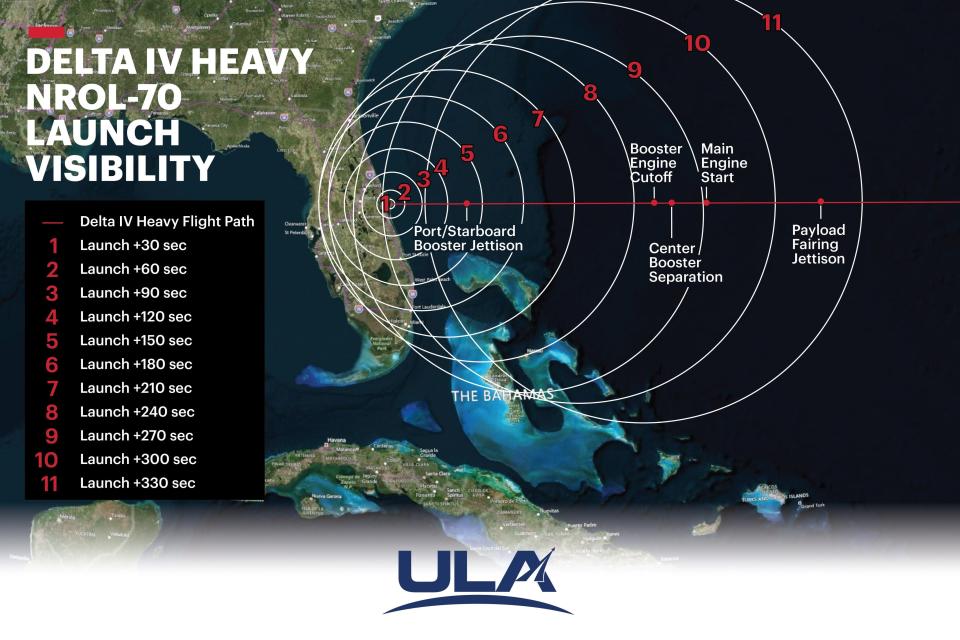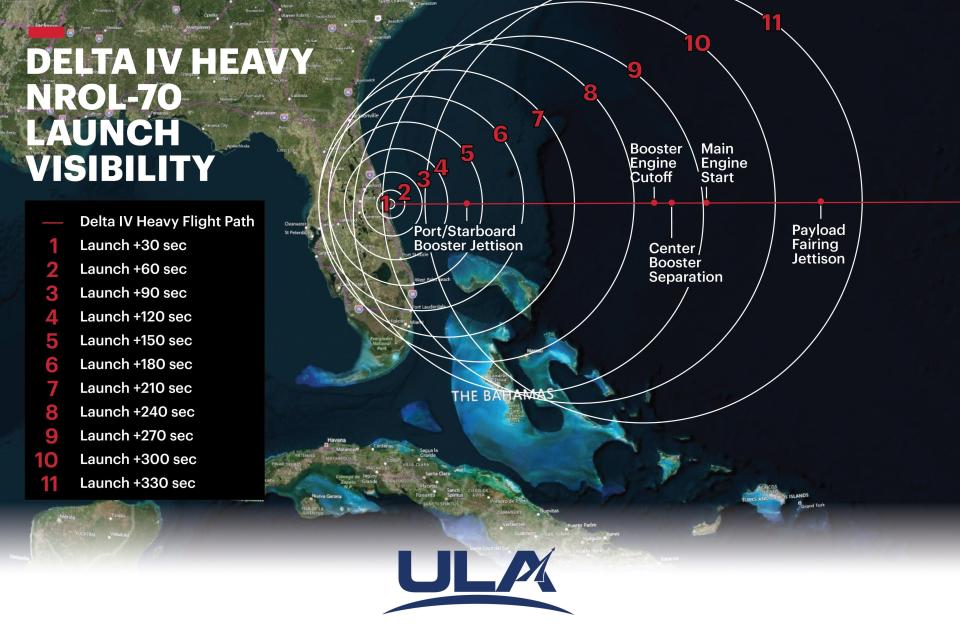
Are you ready? Not one, but two amazing events will potentially happen on the same day, and Florida’s Space Coast will get some of both.
The much-anticipated Delta IV Heavy rocket will potentially launch from Cape Canaveral − for the very last time − on Monday, April 8, with the launch window from 12:57 to 6:51 p.m. EDT. The Great American Solar Eclipse also is Monday, April 8. Because Florida is not in the path of totality, in the Sunshine State it’s referred to as a partial solar eclipse, which starts at 12:35 p.m. CDT through 4:20 p.m. EDT Monday, according to timeanddate.com.
When is United Launch Alliance’s massive Delta IV Heavy rocket going to launch? As of Monday, April 1, the next attempt for its final liftoff ever is coming up, according to an FAA navigational advisory (see below). Here’s what we know about the launch, where it can be seen beyond the Space Coast and the Great American Solar Eclipse.
Is there a rocket launch today? Here’s the upcoming launch schedule for SpaceX, ULA, NASA in Florida (bookmark this link)
When is the Delta IV Heavy rocket launch from Cape Canaveral, Florida?
After a March 25, 2024, scrub due to an issue with a ground pump on a gaseous nitrogen pipeline, a Federal Aviation Administration navigational advisory shows the next launch window will open on Monday, April 8. However, United Launch Alliance has yet to make an announcement. But that may change. Click here for FLORIDA TODAY’s rocket launch calendar, which is updated frequently.
-
Mission: ULA’s last Delta IV Heavy triple-core rocket will launch on the NROL-70 national security mission.
-
Launch window: 12:57 to 6:51 p.m. EDT Monday, April 8
-
Trajectory: Due east
-
Location: Launch Complex 37 at Cape Canaveral Space Force Station
-
Local sonic boom: No
-
Booster landing: None
-
Live coverage: Starts two hours before liftoff at floridatoday.com/space with FLORIDA TODAY’s Space Team.
What is Delta Heavy?
Delta Heavy refers to United Launch Alliance’s Delta IV Heavy rocket. The ULA rocket made history for its transportation of the NASA Parker Solar Probe in 2018 and the first orbital test flight of the Orion crew capsule in 2014.
It was following the success of this flight that NASA’s Orion crew capsule flew on NASA’s Space Launch System (SLS) rocket, successfully demonstrating an uncrewed mission around the moon in 2022. ULA assisted in this flight as well, as the organization designed the upper stage of the SLS rocket.
The Orion spacecraft is set to take Artemis II astronauts around the Moon in late 2025.
How big is Delta IV Heavy rocket? What’s the size and power of ULA Delta IV Heavy rocket?
The Delta IV Heavy rocket has three Delta IV core stages together. According to the ULA website, each rocket engine produces up to 702,000 lbs. of thrust. With this performance, one can see why ULA dubbed it “the most metal.” These engines are not small either. Just one engine weighs around 14,876 pounds and is 204 inches (17 feet) in length.
Powered by liquid hydrogen and liquid oxygen, the Delta IV Heavy appears to “set itself on fire” just before liftoff as buoyant hydrogen gas, which is used to cool down the rocket before launch, ignites and burns off. The fiery start may look frightening, yet it’s part of the process.
In Florida, we can best see this historic moment in person if you’re anywhere on the Space Coast (Brevard County) or certain spots in the First Coast or Fun Coast (Volusia County) or the Treasure Coast (Indian River County, St. Lucie County and Martin County). Pro tip: If you do watch it in person, get to your viewing destination early and prepare to stay later after the launch because of heavy traffic.
Who can see Delta IV Heavy rocket launch from Cape Canaveral, Florida? Which cities can see Delta IV Heavy liftoff?

ULA provided a helpful graphic (see above) that shows Delta IV Heavy’s intended flight path and its launch visibility:
-
Launch, Space Coast, Orlando, northern part of the Treasure Coast, Indian River County, Sebastian, Vero Beach, parts of northern part of Daytona Beach, New Smyrna Beach and Oak Hill
-
1: Launch + 30 seconds, Space Coast, Orlando, northern part of the Treasure Coast, Indian River County, Sebastian, Vero Beach, parts of northern part of Daytona Beach, New Smyrna Beach and Oak Hill
-
2: Launch + 60 seconds, Space Coast, northern part of Daytona Beach, New Smyrna Beach, Treasure Coast, possibly Martin County, possibly St. Lucie County, parts of East-Central Florida like Orlando, near University of Central Florida, Bithlo
-
3: Launch + 90 seconds, visibility extends to Orlando, Sanford, Kissimmee, Daytona Beach, other parts of Central Florida
-
4: Launch + 120 seconds, visibility extends to Port St. Lucie, Lakeland, Sebring, Winter Haven, Palatka, St. Augustine
-
About 130 seconds (Port/Starboard, booster jettison), visibility extends to include most of central and East Coast of Florida
-
5: Launch + 150 seconds, visibility extends to West Palm Beach, Ocala, the Village, Sebring, most of central and East Coast of Florida, Tampa, parts of West Coast of Florida
-
6: Launch + 180 seconds, Jacksonville, Gainesville, Tampa, Arcadia, North Port, West Palm Beach, Boca Raton, Pompano Beach, Fort Lauderdale, most of central and East Coast of Florida, parts of West Coast of Florida
-
7: Launch + 210 seconds, visibility extends to Hollywood, Florida; the Everglades, Hialeah, Miami, most of central and East Coast of Florida, parts of West Coast of Florida
-
8: Launch + 240 seconds (booster engine cutoff); visibility extends to Hollywood, Florida; the Everglades, Hialeah, Miami, most of central and East Coast of Florida, parts of West Coast of Florida. It could include Homestead and possibly Key Largo
-
Beyond 240 seconds, Delta IV Heavy should see center booster separation and main engine start, according to the ULA graphic.
-
9: Launch + 270 seconds, most of central and East Coast of Florida, parts of West Coast of Florida
-
10: Launch + 300 seconds, most of central and East Coast of Florida, parts of West Coast of Florida
-
Beyond 300 seconds, the graphic shows Delta Heavy payload fairing jettison.
-
11: Launch + 330 seconds, most of central and East Coast of Florida, parts of West Coast of Florida
-
Clearwater and St. Petersburg appear to be out of range. Interestingly, the Bahamas and Freeport are in the launch visibility zones.
The above guidelines are estimates based on the graphic provided by ULA.
When is solar eclipse 2024? Is Florida in the path of totality? Will Florida see a total eclipse?
For the Great American Eclipse on April 8, 2024, once again Florida is not in the path of totality, but some parts from northwest Florida (Crestview and Pensacola, for example) will have up to 80% visibility, according to a NASA eclipse map, vs. Homestead and Coral Gables, which will have about 45% visibility.
While the Sunshine State is not in the path of totality, Floridians will still get a view. For example, Florida was not in the path of annularity for the Great American Eclipse or “ring of fire” on Oct. 14, 2023 − meaning Floridians did not see the “ring of fire” effect from the moon partially covering the sun leaving only a ring of bright yellow − however, residents and visitors here saw a partial solar eclipse, like a fat crescent shape.
What time can I see 2024 solar eclipse in Florida?
Though Florida is not in the path of totality for the April 8, 2024, Total Solar Eclipse, the eclipse can still be seen via protective solar eclipse glasses, shadows on the ground or other creative (and safe) means.
In Florida, it’s referred to as a partial solar eclipse, which starts at 12:35 p.m. CDT through 4:20 p.m. EDT Monday, April 8, 2024, according to timeanddate.com.
Can the Great American Eclipse, Total Solar Eclipse 2024 be seen in Florida?
Weather permitting, to see all phases of the total solar eclipse, you must be within the path of totality. According to a map on greatamericaneclipse.com, the U.S. path of totality for the Monday, April 8, 2024, eclipse covers parts of Texas, Arkansas, Oklahoma, Missouri, Illinois, Indiana, Ohio, Pennsylvania, New York, Vermont, New Hampshire and Maine. The total eclipse will not be visible from Florida − unless you watch it virtually from a livestream.
In the U.S., totality will begin in Texas at 1:27 p.m. CT and will end in Maine at 3:35 p.m. ET on April 8, 2024. The state of Florida should have a 45% to 75% chance of “maximum partial eclipse,” according to Great American Eclipse online. Expect to see a thin crescent shape to a thicker crescent shape.
If you’re going to look to the sky for Delta IV Heavy rocket launch in Florida on same day as Great American Eclipse, protect your eyes.
This next section focuses on safety for your eyes. There is a solar eclipse scheduled for the same time as the Delta IV Heavy rocket launch, as of April 1 (things may change with the rocket launch, so check FLORIDA TODAY’s rocket launch calendar, which is updated frequently). When the rocket launches, you’ll look north to the sky toward the direction of Cape Canaveral. The Delta IV Heavy rocket launch window coincides with the partial solar eclipse. Do not look directly up at the sun.
Where do I get solar eclipse glasses for Total Solar eclipse in April 2024?
The American Astronomical Society offers a list of suppliers for safe solar filters and viewers online. Also, various Home Depot, Lowes and Walmart locations sell ISO-compliant safe eclipse glasses and/or handheld viewers, the group states. Some local libraries in Florida also have solar eclipse glasses but are usually first-come, first-serve.
All safe eclipse glasses will meet the “ISO 12312-2” standard. The AAS warns that “NASA does not approve or endorse products. Some vendors print the ISO logo on their viewers or claim that they’re ‘ISO certified,'” according to a blog post on its site, but “ISO prohibits the use of their logo on products and does not certify products.”
To protect your eyes, you’ll want to wear eclipse glasses that are “recognized by the American Astronomical Society’s Solar Eclipse Task Force as a supplier of safe solar viewers/filters,” the AAS site states.
Solar eclipse glasses should have ISO 12312-2. What does ISO 12312-2 mean?
ISO refers to “International Organization for Standardization,” though ISO is derived from the French name.
Safe eclipse glasses that help prevent injury from intense radiation from the sun and provide a satisfying view of the celestial event are categorized with the international standard ISO 12312-2, in short, “eye and face protection” for direct observation of the sun. ISO 12312-2 applies worldwide.
The American Astronomical Society explains that “ISO standards are not laws, though governments sometimes base laws on ISO standards. This means it is not necessarily illegal for a product to fail to meet the requirements of an ISO standard. But it may be inadvisable to buy or use such a product, as failure to meet the requirements of an applicable standard likely means the product is not well suited to its purpose.”
Contributing: Yoonserk Pyun, USA TODAY Network, and Kim Luciani, USA TODAY Network-Florida
Sangalang is a lead digital producer for USA TODAY Network-Florida. Follow her on Twitter or Instagram at @byjensangalang. Support local journalism. Consider subscribing to a Florida newspaper.
Rick Neale is a Space Reporter at FLORIDA TODAY (for more of his stories, click here.) Contact Neale at 321-242-3638 or [email protected]. Twitter/X: @RickNeale1
This article originally appeared on Florida Today: When is Delta 4 Heavy launch from Cape Canaveral? When is solar eclipse?
EMEA Tribune is not involved in this news article, it is taken from our partners and or from the News Agencies. Copyright and Credit go to the News Agencies, email [email protected] Follow our WhatsApp verified Channel









